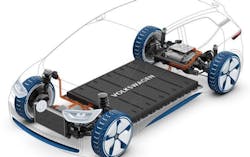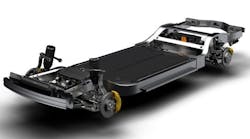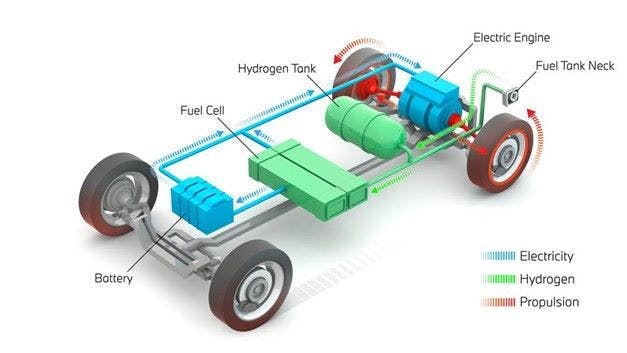One optimization strategy to provide backup storage for the power grid utilizes the electricity storage potential of the world’s electric vehicles (EV) and infrastructure. Today, battery racks of most EVs are used only a couple hours a day. Whenever an EV is idle, its approximately 1,000-pound battery pack (Figure 1) and the 50-KWh electric power it stores do nothing.
There are about 3 million EVs on U.S. roads today, and by 2030 there will be 30 million. By the end of this decade, the combined storage capacity of the battery packs of all U.S. EVs, will exceed 1.5 GWh, which is more than the capacity of the world's largest battery storage system. In other words, these 30 million EVs will store as much power as a day’s output from dozens of nuclear power plants.
Automotive and energy industry experts have long considered using EV car batteries to provide storage for the grid. As the number of electric cars on the road increases, the idea becomes more tangible because newer generations of electric vehicles already offer so-called bidirectional charge capability—meaning a free bidirectional charger comes with the car. The charger,when operating in the "supply from the grid" direction,automatically takes electricity from the grid to recharge the EV's batteries. When operating in the "supply to the grid" direction, it sends stored electricity in the battery-pack to the grid. Bidirectional chargers operate as regular chargers most of the time but can reverse the direction of electricity flow to serve as backup storage for the grid.
The current grid
As green energy sources contribute larger portions of our total energy supply, the amount of energy flowing through the grid must increase becasue of the increasing electricity demanded by EVs, heat pumps and artificial intelligence (AI) data centers. However, the direction of the flow must also reverse whenever green energy sources start or stop feeding electricity into the grid. In its present (one-directional) mode of operation, the grid can’t reverse.
Today, most grids are served by traditional (fossil fuel and nuclear) power plants. These centralized systems supply electricity at different prices, depending on whether it’s purchased during peak or off-peak periods. Peak-period prices are higher because meeting peak loads requires starting new and more expensive-to-operate generating units. In past configurations, users could minimize their total energy costs by minimizing the portion of the electricity they used during peak periods.
The bidirectional grid
Today, in addition to transporting electricity from traditional power plants, the grid must also transport "green electricity" generated intermittently, which comes online or offline quickly. In Germany, when green power supplies came on, their electricity overloaded the grid because conventional power plants couldn’t cut production fast enough, and users couldn’t increase their demand fast enough, even if when the cost of electricity dropped to zero. The same problem occurs when the green electricity supply suddenly stops because conventional power plants can’t increase production fast enough to compensate for the drop.
For the grid to simultaneously transport conventional and green electricity, the total electricity distribution system must include storage, and to use that storage it must become bidirectional. Storage is provided in batteries, in hydrogen, by pumped hydraulic systems, etc.
Cutting costs in half
I recommend that all EV suppliers provide vehicles with bidirectional chargers free of charge, so their cars automatically recharge their batteries when electricity is inexpensive during off-peak periods, or automatically send their unneeded, stored electricity back to the grid during peak periods. By providing this bidirectional electricity transfer capability (buy low, sell high), EV manufacturers give car owners the ability to minimize their monthly electricity bills. This ability also reduces the operating cost of EVs, and provides the grid with backup electricity storage, which it needs when green electricity supplies stop or start up again.
The role of the process control profession in implementing this strategy is a critical one because it must design the intelligent and automatic operation of the bidirectional chargers and its displays so that, once the minimum storage limit is set, all the car owner must remember is connect the charger.
The future of EVs
In the long term, EVs will become our main means of transportation. However, their fuel won’t be stored in batteries, but in light and green hydrogen tanks that generate electricity via fuel cells (Figure 2). This won’t occur any time soon because new water electrolyzers must be invented to reduce the cost of green hydrogen to about $2/kg and because financial interests and the views of climate-change deniers also must be overcome.
Today, battery-fueled electric vehicle (BEV) suppliers have successfully delayed this trend by experimenting with car wash-style (drive-thru), battery-pack switching stations to cut refueling time to a few minutes. They’ve also increased the power density of their batteries, which is presently 0.15-0.25 kWh per kilogram of battery, while 1 kg of hydrogen provides 39.6 kWh.
While BEVs will be around for a decade or two, the safety consequences of increasing their power density and market forces resulting from their limited supply will make the eventual switch from batteries to fuel cells unavoidable.








